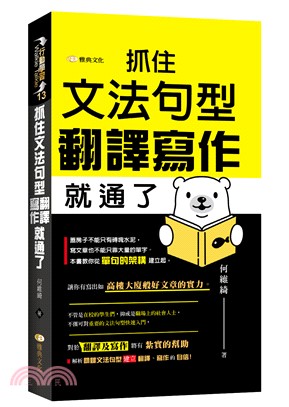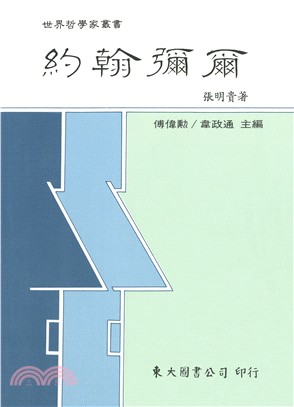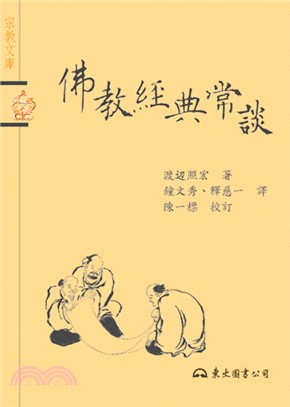商品簡介
本書教你從單句的架構建立起,讓你有寫出如高樓大廈般好文章的實力。
不管是在校的學生們,抑或是職場上的社會人士,
不僅可對重要的文法句型快速入門,對於翻譯及寫作將有紮實的幫助!
解析關鍵文法句型,建立翻譯、寫作的自信!
只要有翻譯和寫作的需要,不論是想通過學測的高中生或是想通過英檢寫作的國高中生、大專生,或是有檢定考試寫作需求的社會人士,都可以透過本書提高翻譯及寫作能力。
書摘/試閱
一、認識英文句子的結構
(一) 對等連接詞:
主要有and, or, but, so。可將兩個單句連接起來,使其變成複句。
1:句 + (,) 對等連接詞(and/or/but/so) + 句.
The young couple sang and (the young couple) danced all night.
那對年輕夫婦通宵唱歌跳舞。
Get up earlier, or you'll be late.
早點起床,否則你會遲到。
It is hot in summer in Kaohsiung, but it is not cold in winter.
高雄夏天熱,但冬天不冷。
He was sick, so he didn't go to school yesterday.
他生病了,所以昨天沒有上學。
【注意】
★以上四個為最常見的對等連接詞,其他偶爾會看到的還有:
1. 句, for+句.
→[for為對等連接詞,表原因]
You should stop smoking, for it is not good for your health.
你應該要戒菸,因為那對你的健康無益。
2. 句, yet/while/whereas+句.
→[yet/while/whereas為對等連接詞,表「然而,但是」]
She didn't know me, yet she helped me.
= She didn't know me, while she helped me.
= She didn't know me, whereas she helped me.
她不認識我,但是卻幫了我。
文法練習題
1. He went to Hong Kong in 1980 _______ (he) has lived
there ever since.
(A) and
(B) or
(C) ,
(D) X
2. She was exhausted ______ she didn't go to the party
last night.
(A) but
(B) so
(C) ,
(D) X
解答: 1. A2. B
翻譯練習題
1. 你想要在家裡吃晚餐或是出去吃?
2. 他很生氣,但還是聽了老婆的話。
解答:
1. Would you like to eat dinner at home or (would you like to) dine out?
2. He was very angry, but he still listened to his wife.
2:如果第一個句子已經很長了,這時可以選擇以下句型來呈現兩個句子:
句. 對等連接詞(And/Or/But/So) + 句.
Many foreign students think that it is very hard to learn to speak Chinese. But if they keep practicing speaking Chinese, they can become fluent little by little.
許多外國學生認為學習說中文很難。但是只要經常練習,就可以漸漸變得流利。
He failed the exam, lost his wallet, and had a fight with his girlfriend yesterday. So don't bother him anymore.
昨天他沒通過考試,丟了錢包,又跟女朋友吵架。所以不要再煩他了。
文法練習題
1. When he was a senior high school student, he did not like to go to school because his teachers gave tests every day. ______ he hated tests.
(A) Or
(B) So
(C) And
(D) Instead
2. His father had been out of work for two years, and his mother had been in hospital for two months. ______ it was hard for him to make ends meet.
(A) But
(B) Luckily
(C) So
(D) Instead
解答: 1. C2. C
翻譯練習題
1.考試可以激勵學生用功,也可以增進閱讀能力。但是考試太多對他們的健康有害。
2. 派對要到晚上八點才開始,所以我們可以晚點出發。還是你想現在動身?
解答:
1. Tests can stimulate students to hard work, and enhance reading ability. But too many tests are harmful to their health.
2. The party won't take place until 8 p.m., so we can set off later. Or do you want to leave now?
(二) 三大子句:名詞子句、形容詞子句、
副詞子句
1:名詞子句 → 功用是作為:S或O或C
(1) that + 完整句
That he stole your book is a truth.
他偷了你的書是事實。
→紅色部分為that + 完整句,作為主詞(S)
I dozed off and didn't realize that I had missed an
important discussion.
我打瞌睡,不知道自己已經錯過了一個重要的討論。
→紅色部分為that + 完整句,作為受詞(O)
The fact is that the salesperson is dishonest.
事實是這個業務員不老實。
→紅色部分為that + 完整句,作為補語(C)
【注意】that + 完整句,也可以作為同位語。
You should wake up to the fact that it's a tough world.
你應該領悟到這是個殘酷的世界。
→紅色部分為that + 完整句,作為the fact的同位語。
This film was based on the idea that all people have the right of freedom of speech.
這部電影是基於人人皆有言論自由。
→紅色部分為that + 完整句,作為the idea的同位語。
The idea that there is really no predictability in nature has led to the conception that the universe must be
fundamentally chaotic.
自然是不可測的這個想法引導出宇宙基本上是混亂的這個見解。
→紅色部分為that + 完整句,作為the idea和the
conception的同位語。
It is a miracle that she could escape from the kidnapper's place without a scratch.
她能從綁匪之處安然逃脫,真是奇蹟。
→紅色部分為that + 完整句,作為a miracle的同
位語。
She broke up with him after the revelation that he was addicted to gambling.
在發現他沉迷賭博後,她跟他分手了。
→紅色部分為that + 完整句,作為the revelation的同位語。
【注意】兩個或多個that所引導的名詞子句當同一vt.的受詞時,只有第一個that可以省略,其他不可省略。
The thief said (vt.) (that) he was sorry, and that
(不可省) he couldn't find a job for a long time.
這個小偷說他很抱歉,很長一段時間他找不到工作。
【補充說明】完整句的定義:[不缺S或O]
1. S + Vt. + O.
I like your watch.
我喜歡你的錶。
2. S + Vi. (+ 介 + O.)
He often lies, so I don't like to talk to him.
他常常說謊,所以我不喜歡跟他說話。
3. S + be + pp
He was blamed for his laziness by his parents.
他的父母親因為他的懶惰而責備他。
(2) whether + 完整句
★引導名詞子句時or not可放句尾或省略
I doubt whether she likes me (or not).
我懷疑她是否喜歡我。
(3) where/when/how/why + 完整句
what/who(m) + 不完整句 [缺S或O或C]
We don't know | where the superstar lives.
| when the old man died.
| how the dog got lost.
| why the teacher was so angry.
| what the little girl is looking for.
| who(m) the boy is talking with.
我們不知道那個巨星住在哪裡。
我們不知道那個老先生何時過世。
我們不知道那隻狗怎麼迷失的。
我們不知道老師為何那麼生氣。
我們不知道這個小女孩在找什麼。
我們不知道這個男孩在跟誰說話。
文法練習題
1. We don't know ______ the thief has the face to ask for such a thing.
(A) what
(B) which
(C) who
(D) how
2. He was sleeping then, so he didn't realize ______ was going on.
(A) what
(B) which
(C) that
(D) how
解答: 1. D2. A
翻譯練習題
1.麗莎很容易隨心所欲而不顧及他人感受。
2.你絕對不會體會到你的父母在1940年代時生活的狀態。
解答:
1. Lisa tends to do what she wants to do without considering people's feelings.
2. You would never know what your parents' life would be like in the 1940s.
2:形容詞子句
→ 功用:放在一個名詞後面,來修飾這個名詞
→ 出現的時機很容易判斷,如下:N + 形容詞子句
→必須由關係代名詞(which/who/whom/whose/that),所引導出
→ 關係代名詞的檢查法:
(1) 前面有前置詞(N)。關代就是來取代這個前置詞。
(2) 關代取代後,此關代在其引導的子句中當S
或O。
【公式一】N +《關代 + 不完整句》
The parrot likes to imitate sounds which it heard.
那隻鸚鵡喜歡模仿聽到的聲音。
→N (sounds) + 關代(which) + 不完整句(it heard)
(缺受詞)
→which 在其後子句中當O,引導形容詞子句(which it heard),來修飾 sounds。
They were the first men who joined in the singing
contest.
他們是最先參加這個唱歌比賽的人。
→N (men) + 關代(who) + 不完整句(joined in the singing contest)(缺主詞)
→who在其後子句中當S,引導形容詞子句(who joined in the singing contest),來修飾the first men
【公式二】N +《whose + N + 不完整句》
The student comes from an old town whose history goes back to thousands of years.
這個學生來自一個歷史可追溯到幾千年前的古鎮。
→N (town) + whose + N (history) + 不完整句(goes back to thousands of years) (缺主詞)
→whose history在其後子句中當S,引導形容詞子句(whose history goes back to thousands of years),來修飾town
【公式三】 N +《介 + 關代 + 完整句》
→此時的 介 + 關代 = 關係副詞 (下面的章節會詳細
介紹)
The ground on which the main actor was standing
began to crack.
那個男主角所站立的地面開始破裂。
→N (ground) + 介(on) + 關代(which) + 完整句(the main actor was standing)
→形容詞子句為(on which the main actor was standing),修飾前置詞ground (N)
文法練習題
1. The tall building, ______ the Lins lived in, fell down
during the earthquake.
(A) which
(B) in that
(C) where
(D) whose
2. His parents try to reduce the impact ______ television
violence will have on him.
(A) where
(B) whose
(C) who
(D) that
解答: 1. A2. D
翻譯練習題
1. 約翰看到他所尊敬的那位老師。〔用關係代名詞whom〕
2. 台北是維琪出生的城市。〔用關係代名詞which〕
解答:
1. John saw the teacher whom he respects.
2. Taipei is the city which is Vicky's birthplace.
【公式四】關係代名詞的省略 (第一種)
→關係代名詞當其引導的形容詞子句的主詞時,就可進行省略
★省略三步驟:
(1) 去掉關係代名詞
(2) 其後動詞改成V-ing (現在分詞)
(3) 如這個V-ing (現在分詞),為 being, 則要去掉
There are plenty of songs which are written in
Taiwanese for us to sing.
有許多用台語寫的歌可供我們歌唱。
→省略三步驟:
第一步去掉which;第二步are改成 being;第三步去掉being
→所以經過省略之後的句子為There are plenty of songs written in Taiwanese for us to sing.
The man who wears a hat is her boyfriend.
那個戴著帽子的男人是她的男友。
→省略三步驟:
第一步去掉who;第二步wears改成wearing
→所以經過省略之後的句子為The man wearing a hat is her boyfriend.
文法練習題
1. I didn't hear anything about the accident _______ in
their community yesterday.
(A) happened
(B) happening
(C) which was happened
(D) which happening
2. We can see a messy bed ________ with dirty clothes.
(A) covering
(B) whose covering
(C) which covered
(D) covered
解答: 1. B2. D
翻譯練習題
1. 新搬來我們公寓的住客是個很害羞的人。
2. 夜晚橫越星空看見的銀河是如此美麗。
解答:
1. The resident newly moving to our apartment is a very shy person.
2. The Milky Way seen across the sky at night is so beautiful.
【公式四】關係代名詞的省略 (第二種)
→關係代名詞當其引導的形容詞子句的受詞時,「前面沒有逗點或介系詞」,就可以直接省略。
I will never forget the lady (whom) I met yesterday.
我絕對不會忘記昨天遇到的那個女士。
→關代在其引導的形容詞子句(whom) I met yesterday中,作為動詞met的受詞,所以可以直接省略。
文法練習題
1. The window _________ you are sitting by is broken.
(A) X
(B) whose
(C) where
(D) whom
2. Where is the gift box _______ I received last week?
(A) whose
(B) who
(C) X
(D) whom
解答: 1. A 2. C
主題書展
更多主題書展
更多書展本週66折
您曾經瀏覽過的商品
購物須知
為了保護您的權益,「三民網路書店」提供會員七日商品鑑賞期(收到商品為起始日)。
若要辦理退貨,請在商品鑑賞期內寄回,且商品必須是全新狀態與完整包裝(商品、附件、發票、隨貨贈品等)否則恕不接受退貨。

























